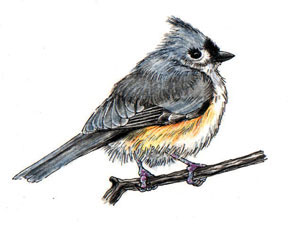Good things come in small packages is no exception with the titmice. They are pretty and fun to have in the backyard as well as being good insect eaters.
 |
Titmice are small perky bluish-gray birds with short bills and compact bodies, slightly larger than chickadees with whom they often flock. All four kinds of titmice sport distinctive crests. They have dark, alert round eyes. Males and females look similar, their young typically appearing as slightly paler, more beige versions of their parents.
Two kinds of titmice are year round residents in regions of the U.S. Both the tufted titmouse in the East and the plain titmouse in the West inhabit large portions of these regions. Backyard feeding has so enhanced their winter survival that their ranges keep extending. Two other titmice, the black-crested titmouse and the bridled titmouse, are primarily citizens of Mexico, frequenting parts of Texas as well.
Recognizing a Tufted Titmouse (Parous bicolor)
Along with black-capped chickadees, tufted titmice are one of the best known birds in the East because they are frequent visitors to feeders, particularly where winters are snowy. Quite tame around people, they will visit feeders less often when food is available in the wild. From March through June they are preoccupied with courting and nesting.
Tufted titmice are only 5½ inches long with tufted crests on their heads, black patches above their bills and bluish gray backs and wings. They have pale breasts, traced with streaks of rusty color just below each wing. Those from Texas and the Great Plains areas have black crests. Their clarion peto-peto-peto whistle announces their presence during the months when they actively flit about the yard-seeking insects to eat. Throughout their range from Canada to the Gulf of Mexico, they are found in woodlands, groves of shade trees and conifers, along streams, in swamps, orchards and suburban parks and yards.
Recognizing a Plain Titmouse (Parus inoratus)
Plain titmice are, well, plain. Just under 5½ half inches long, they have drab, slate gray crests, backs and wings and slightly paler gray breasts. Their gray color is variable, coastal plain titmice being more brown. Plain titmice are less likely than other titmice to travel in flocks. Alert and inquisitive, they actively hunt insects in woods and yards, sometimes by hanging upside down like a nuthatch.
Like chickadees, plain titmice frequent stands of oaks, pinyon and juniper, especially forest edges in the mountain-desert regions and the Pacific coast areas. However, they are not present in every location within these regions, particularly the northwest portion of the country.

